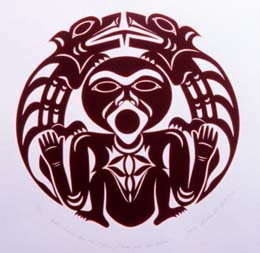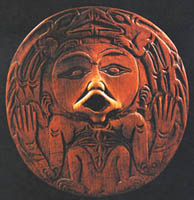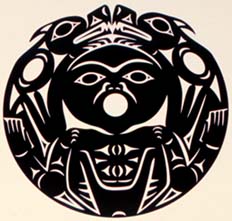 Man and Sea Otters
Man and Sea Otters04/81 Susan A. Sparrow
Edition: 12/100 Silkscreen
© Copyright 1981 Susan A. Point. All Rights Reserved.
This is Susan Point's first commercial serigraph. The artist's early works are signed "Susan A. Sparrow", although after 1983, she began using her maiden name, Point. The design for this image is based on a spindle whorl found in the collections of the British Columbia Provincial Museum. In reference to her earliest works, Point states: "When I first started out I was more or less copying, right from the whorl." (Duffek 1986:3) In Man and Sea Otters, her design is faithful to both the form and imagery of the carved whorl shown on the right.
 (© Copyright
1984 The Royal British Columbia Museum. All Rights Reserved.) Her flowing lines
and balanced use of negative and positive space suggest the rhythmic motion
of the original object in use. Point's print depicts a human figure, seated
between two otters that curve to form an arc over the seated figure's head.
The central circle of the figure's head echoes the overall shape of the image,
which is in turn repeated by the figure's round, open mouth. These concentric
forms, taken together with the overall symmetry of the image, create an easy
flow between the elements of the composition. The figure's open mouth suggests
the opening of the carved spindle whorl, where a wooden shaft would pierce it
to form the tool for spinning yarn. Unlike northern Northwest Coast design,
which is comprised of formlines, u-shapes, and oviods, Coast Salish design is
characterized by stylistic elements such as trigons, crescents, and circles.
These forms can be seen in the backs and articulated fore-legs of the sea otters,
as well as the facial elements of both the human figure and the otters. In a
carving, these elements would have been the incised areas, or negative space,
of the image. In the print, these elements blend with the background, forcing
the darker image to "pop" out at the viewer. This replicates the relationship
between positive and negative space as it would have appeared in a carving.
(© Copyright
1984 The Royal British Columbia Museum. All Rights Reserved.) Her flowing lines
and balanced use of negative and positive space suggest the rhythmic motion
of the original object in use. Point's print depicts a human figure, seated
between two otters that curve to form an arc over the seated figure's head.
The central circle of the figure's head echoes the overall shape of the image,
which is in turn repeated by the figure's round, open mouth. These concentric
forms, taken together with the overall symmetry of the image, create an easy
flow between the elements of the composition. The figure's open mouth suggests
the opening of the carved spindle whorl, where a wooden shaft would pierce it
to form the tool for spinning yarn. Unlike northern Northwest Coast design,
which is comprised of formlines, u-shapes, and oviods, Coast Salish design is
characterized by stylistic elements such as trigons, crescents, and circles.
These forms can be seen in the backs and articulated fore-legs of the sea otters,
as well as the facial elements of both the human figure and the otters. In a
carving, these elements would have been the incised areas, or negative space,
of the image. In the print, these elements blend with the background, forcing
the darker image to "pop" out at the viewer. This replicates the relationship
between positive and negative space as it would have appeared in a carving. Man with Wolves
Man with Wolves1979 Stan Greene
Silkscreen
© Copyright Stan Greene. All Rights Reserved.
Stan Greene, another Coast Salish artist interested in reviving traditional Coast Salish design, has also based designs for his prints on the same spindle whorl, indicating the popularity among artists of using museums' collections as artistic resources. However, each artist's work reflects the subject matter of the original artifact interpreted by his or her own artistic vision, thus each artist has produced significantly different works based on the same object.
